Incentive Salience Theory: Evidence and Treatment of Addiction
VerifiedAdded on 2022/11/29
|13
|4383
|176
Essay
AI Summary
This essay delves into the Incentive Salience Theory of addiction, a prominent psychological framework explaining the development and maintenance of substance use disorders. The essay begins by defining addiction and exploring the various factors that contribute to it, such as financial strain and relationship problems. It then introduces the Incentive Salience Theory, which posits that addiction arises from an excessive desire for a substance, driven by the rewarding effects it produces. The theory emphasizes the role of motivation in controlling addiction. The essay provides supporting evidence for the theory, referencing studies that demonstrate how drug-related cues can trigger cravings and influence behavior. Finally, the essay analyzes the effectiveness of the Incentive Salience Theory and its implications for addiction treatment, suggesting that interventions focused on reducing cravings and enhancing self-control may be beneficial. The essay concludes by highlighting the importance of understanding the psychological mechanisms underlying addiction to develop effective treatment strategies.
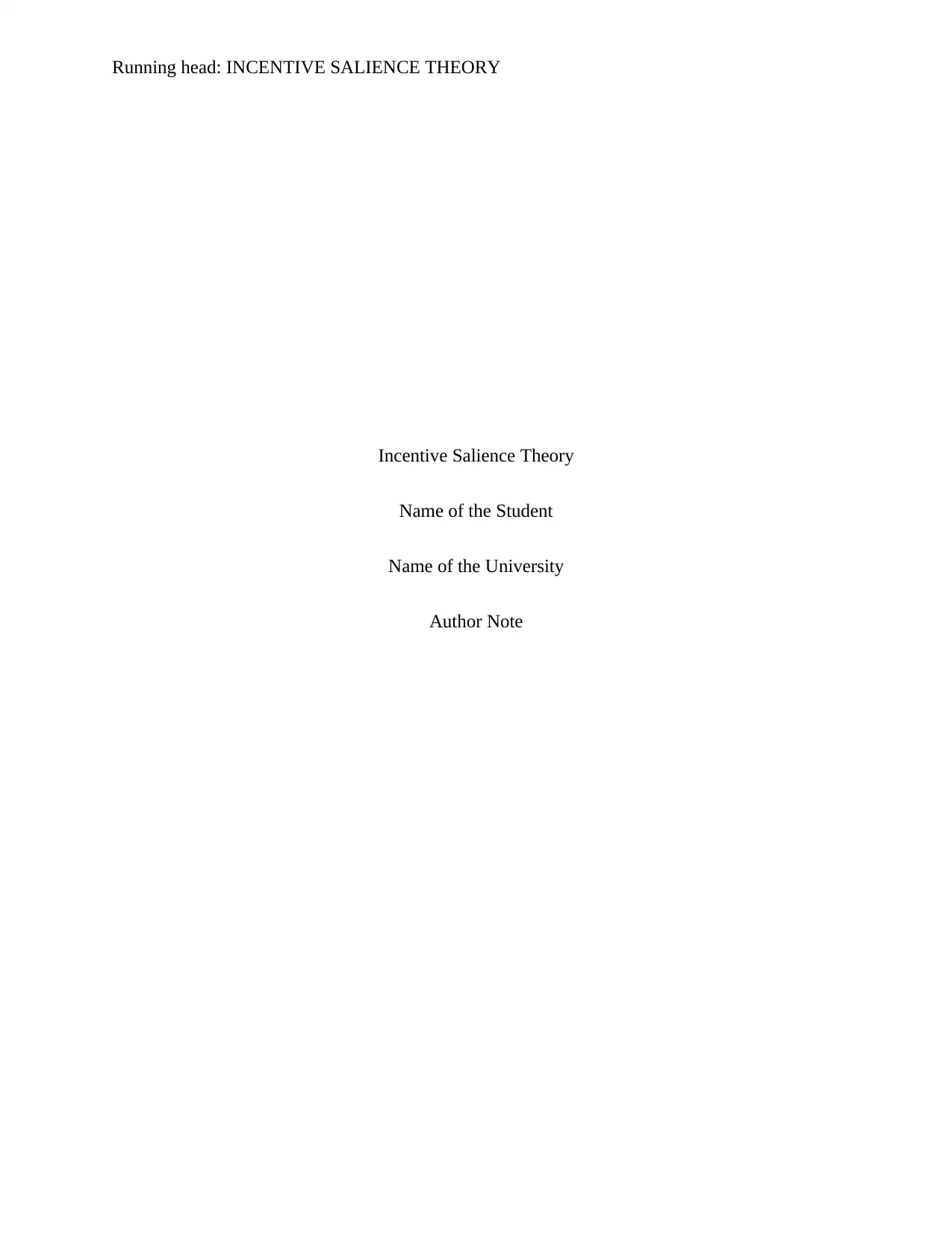
Running head: INCENTIVE SALIENCE THEORY
Incentive Salience Theory
Name of the Student
Name of the University
Author Note
Incentive Salience Theory
Name of the Student
Name of the University
Author Note
Secure Best Marks with AI Grader
Need help grading? Try our AI Grader for instant feedback on your assignments.
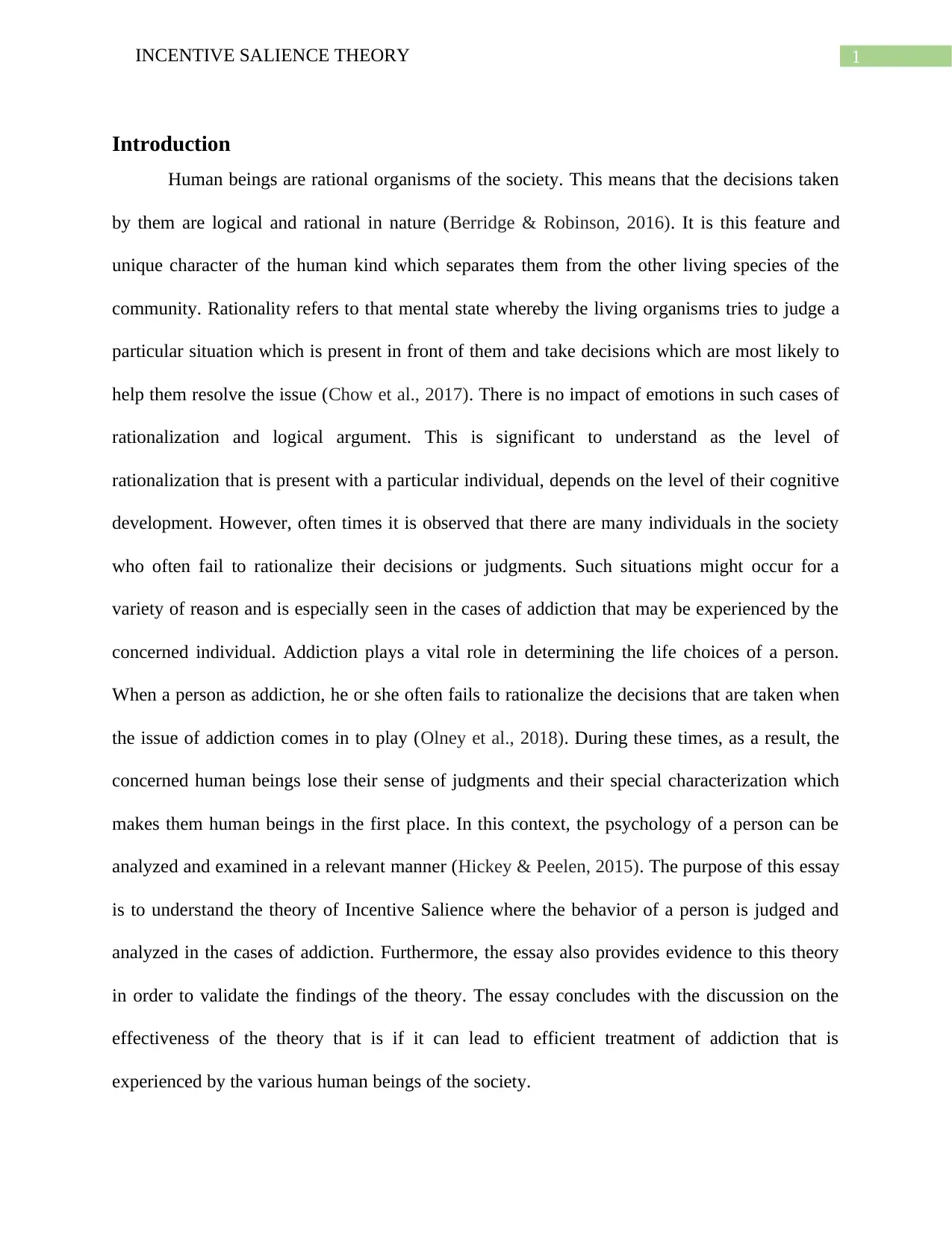
1INCENTIVE SALIENCE THEORY
Introduction
Human beings are rational organisms of the society. This means that the decisions taken
by them are logical and rational in nature (Berridge & Robinson, 2016). It is this feature and
unique character of the human kind which separates them from the other living species of the
community. Rationality refers to that mental state whereby the living organisms tries to judge a
particular situation which is present in front of them and take decisions which are most likely to
help them resolve the issue (Chow et al., 2017). There is no impact of emotions in such cases of
rationalization and logical argument. This is significant to understand as the level of
rationalization that is present with a particular individual, depends on the level of their cognitive
development. However, often times it is observed that there are many individuals in the society
who often fail to rationalize their decisions or judgments. Such situations might occur for a
variety of reason and is especially seen in the cases of addiction that may be experienced by the
concerned individual. Addiction plays a vital role in determining the life choices of a person.
When a person as addiction, he or she often fails to rationalize the decisions that are taken when
the issue of addiction comes in to play (Olney et al., 2018). During these times, as a result, the
concerned human beings lose their sense of judgments and their special characterization which
makes them human beings in the first place. In this context, the psychology of a person can be
analyzed and examined in a relevant manner (Hickey & Peelen, 2015). The purpose of this essay
is to understand the theory of Incentive Salience where the behavior of a person is judged and
analyzed in the cases of addiction. Furthermore, the essay also provides evidence to this theory
in order to validate the findings of the theory. The essay concludes with the discussion on the
effectiveness of the theory that is if it can lead to efficient treatment of addiction that is
experienced by the various human beings of the society.
Introduction
Human beings are rational organisms of the society. This means that the decisions taken
by them are logical and rational in nature (Berridge & Robinson, 2016). It is this feature and
unique character of the human kind which separates them from the other living species of the
community. Rationality refers to that mental state whereby the living organisms tries to judge a
particular situation which is present in front of them and take decisions which are most likely to
help them resolve the issue (Chow et al., 2017). There is no impact of emotions in such cases of
rationalization and logical argument. This is significant to understand as the level of
rationalization that is present with a particular individual, depends on the level of their cognitive
development. However, often times it is observed that there are many individuals in the society
who often fail to rationalize their decisions or judgments. Such situations might occur for a
variety of reason and is especially seen in the cases of addiction that may be experienced by the
concerned individual. Addiction plays a vital role in determining the life choices of a person.
When a person as addiction, he or she often fails to rationalize the decisions that are taken when
the issue of addiction comes in to play (Olney et al., 2018). During these times, as a result, the
concerned human beings lose their sense of judgments and their special characterization which
makes them human beings in the first place. In this context, the psychology of a person can be
analyzed and examined in a relevant manner (Hickey & Peelen, 2015). The purpose of this essay
is to understand the theory of Incentive Salience where the behavior of a person is judged and
analyzed in the cases of addiction. Furthermore, the essay also provides evidence to this theory
in order to validate the findings of the theory. The essay concludes with the discussion on the
effectiveness of the theory that is if it can lead to efficient treatment of addiction that is
experienced by the various human beings of the society.
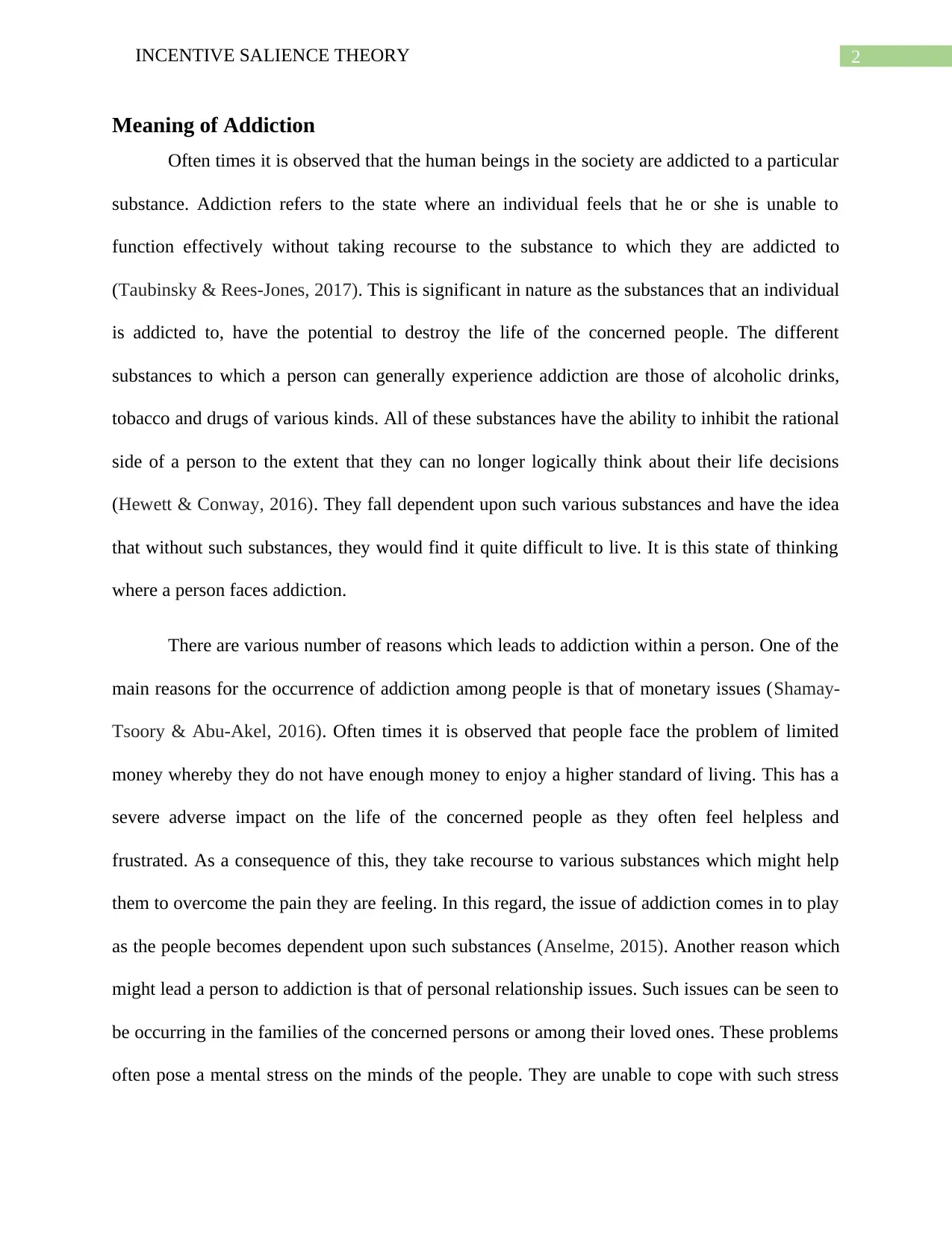
2INCENTIVE SALIENCE THEORY
Meaning of Addiction
Often times it is observed that the human beings in the society are addicted to a particular
substance. Addiction refers to the state where an individual feels that he or she is unable to
function effectively without taking recourse to the substance to which they are addicted to
(Taubinsky & Rees-Jones, 2017). This is significant in nature as the substances that an individual
is addicted to, have the potential to destroy the life of the concerned people. The different
substances to which a person can generally experience addiction are those of alcoholic drinks,
tobacco and drugs of various kinds. All of these substances have the ability to inhibit the rational
side of a person to the extent that they can no longer logically think about their life decisions
(Hewett & Conway, 2016). They fall dependent upon such various substances and have the idea
that without such substances, they would find it quite difficult to live. It is this state of thinking
where a person faces addiction.
There are various number of reasons which leads to addiction within a person. One of the
main reasons for the occurrence of addiction among people is that of monetary issues (Shamay-
Tsoory & Abu-Akel, 2016). Often times it is observed that people face the problem of limited
money whereby they do not have enough money to enjoy a higher standard of living. This has a
severe adverse impact on the life of the concerned people as they often feel helpless and
frustrated. As a consequence of this, they take recourse to various substances which might help
them to overcome the pain they are feeling. In this regard, the issue of addiction comes in to play
as the people becomes dependent upon such substances (Anselme, 2015). Another reason which
might lead a person to addiction is that of personal relationship issues. Such issues can be seen to
be occurring in the families of the concerned persons or among their loved ones. These problems
often pose a mental stress on the minds of the people. They are unable to cope with such stress
Meaning of Addiction
Often times it is observed that the human beings in the society are addicted to a particular
substance. Addiction refers to the state where an individual feels that he or she is unable to
function effectively without taking recourse to the substance to which they are addicted to
(Taubinsky & Rees-Jones, 2017). This is significant in nature as the substances that an individual
is addicted to, have the potential to destroy the life of the concerned people. The different
substances to which a person can generally experience addiction are those of alcoholic drinks,
tobacco and drugs of various kinds. All of these substances have the ability to inhibit the rational
side of a person to the extent that they can no longer logically think about their life decisions
(Hewett & Conway, 2016). They fall dependent upon such various substances and have the idea
that without such substances, they would find it quite difficult to live. It is this state of thinking
where a person faces addiction.
There are various number of reasons which leads to addiction within a person. One of the
main reasons for the occurrence of addiction among people is that of monetary issues (Shamay-
Tsoory & Abu-Akel, 2016). Often times it is observed that people face the problem of limited
money whereby they do not have enough money to enjoy a higher standard of living. This has a
severe adverse impact on the life of the concerned people as they often feel helpless and
frustrated. As a consequence of this, they take recourse to various substances which might help
them to overcome the pain they are feeling. In this regard, the issue of addiction comes in to play
as the people becomes dependent upon such substances (Anselme, 2015). Another reason which
might lead a person to addiction is that of personal relationship issues. Such issues can be seen to
be occurring in the families of the concerned persons or among their loved ones. These problems
often pose a mental stress on the minds of the people. They are unable to cope with such stress
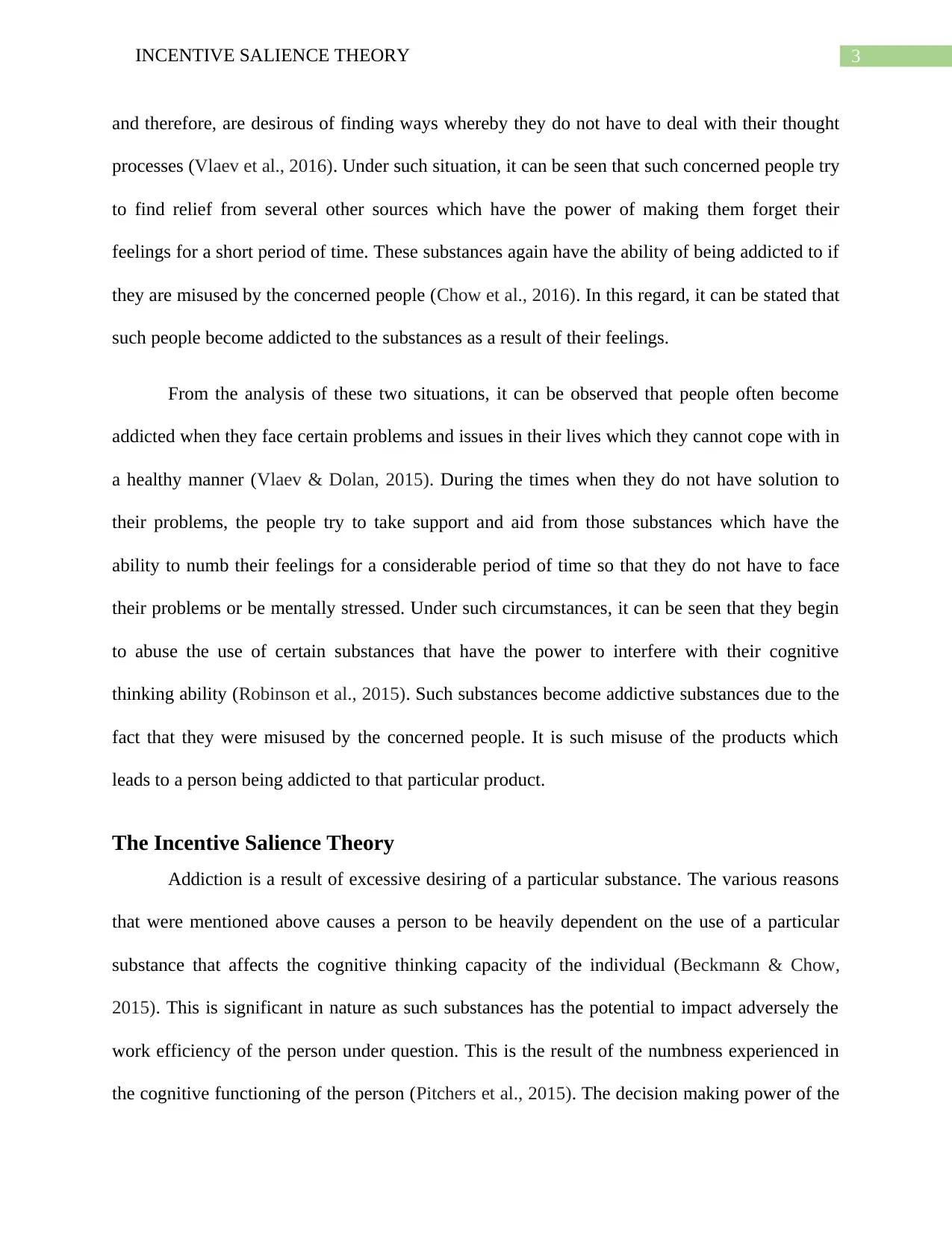
3INCENTIVE SALIENCE THEORY
and therefore, are desirous of finding ways whereby they do not have to deal with their thought
processes (Vlaev et al., 2016). Under such situation, it can be seen that such concerned people try
to find relief from several other sources which have the power of making them forget their
feelings for a short period of time. These substances again have the ability of being addicted to if
they are misused by the concerned people (Chow et al., 2016). In this regard, it can be stated that
such people become addicted to the substances as a result of their feelings.
From the analysis of these two situations, it can be observed that people often become
addicted when they face certain problems and issues in their lives which they cannot cope with in
a healthy manner (Vlaev & Dolan, 2015). During the times when they do not have solution to
their problems, the people try to take support and aid from those substances which have the
ability to numb their feelings for a considerable period of time so that they do not have to face
their problems or be mentally stressed. Under such circumstances, it can be seen that they begin
to abuse the use of certain substances that have the power to interfere with their cognitive
thinking ability (Robinson et al., 2015). Such substances become addictive substances due to the
fact that they were misused by the concerned people. It is such misuse of the products which
leads to a person being addicted to that particular product.
The Incentive Salience Theory
Addiction is a result of excessive desiring of a particular substance. The various reasons
that were mentioned above causes a person to be heavily dependent on the use of a particular
substance that affects the cognitive thinking capacity of the individual (Beckmann & Chow,
2015). This is significant in nature as such substances has the potential to impact adversely the
work efficiency of the person under question. This is the result of the numbness experienced in
the cognitive functioning of the person (Pitchers et al., 2015). The decision making power of the
and therefore, are desirous of finding ways whereby they do not have to deal with their thought
processes (Vlaev et al., 2016). Under such situation, it can be seen that such concerned people try
to find relief from several other sources which have the power of making them forget their
feelings for a short period of time. These substances again have the ability of being addicted to if
they are misused by the concerned people (Chow et al., 2016). In this regard, it can be stated that
such people become addicted to the substances as a result of their feelings.
From the analysis of these two situations, it can be observed that people often become
addicted when they face certain problems and issues in their lives which they cannot cope with in
a healthy manner (Vlaev & Dolan, 2015). During the times when they do not have solution to
their problems, the people try to take support and aid from those substances which have the
ability to numb their feelings for a considerable period of time so that they do not have to face
their problems or be mentally stressed. Under such circumstances, it can be seen that they begin
to abuse the use of certain substances that have the power to interfere with their cognitive
thinking ability (Robinson et al., 2015). Such substances become addictive substances due to the
fact that they were misused by the concerned people. It is such misuse of the products which
leads to a person being addicted to that particular product.
The Incentive Salience Theory
Addiction is a result of excessive desiring of a particular substance. The various reasons
that were mentioned above causes a person to be heavily dependent on the use of a particular
substance that affects the cognitive thinking capacity of the individual (Beckmann & Chow,
2015). This is significant in nature as such substances has the potential to impact adversely the
work efficiency of the person under question. This is the result of the numbness experienced in
the cognitive functioning of the person (Pitchers et al., 2015). The decision making power of the
Secure Best Marks with AI Grader
Need help grading? Try our AI Grader for instant feedback on your assignments.
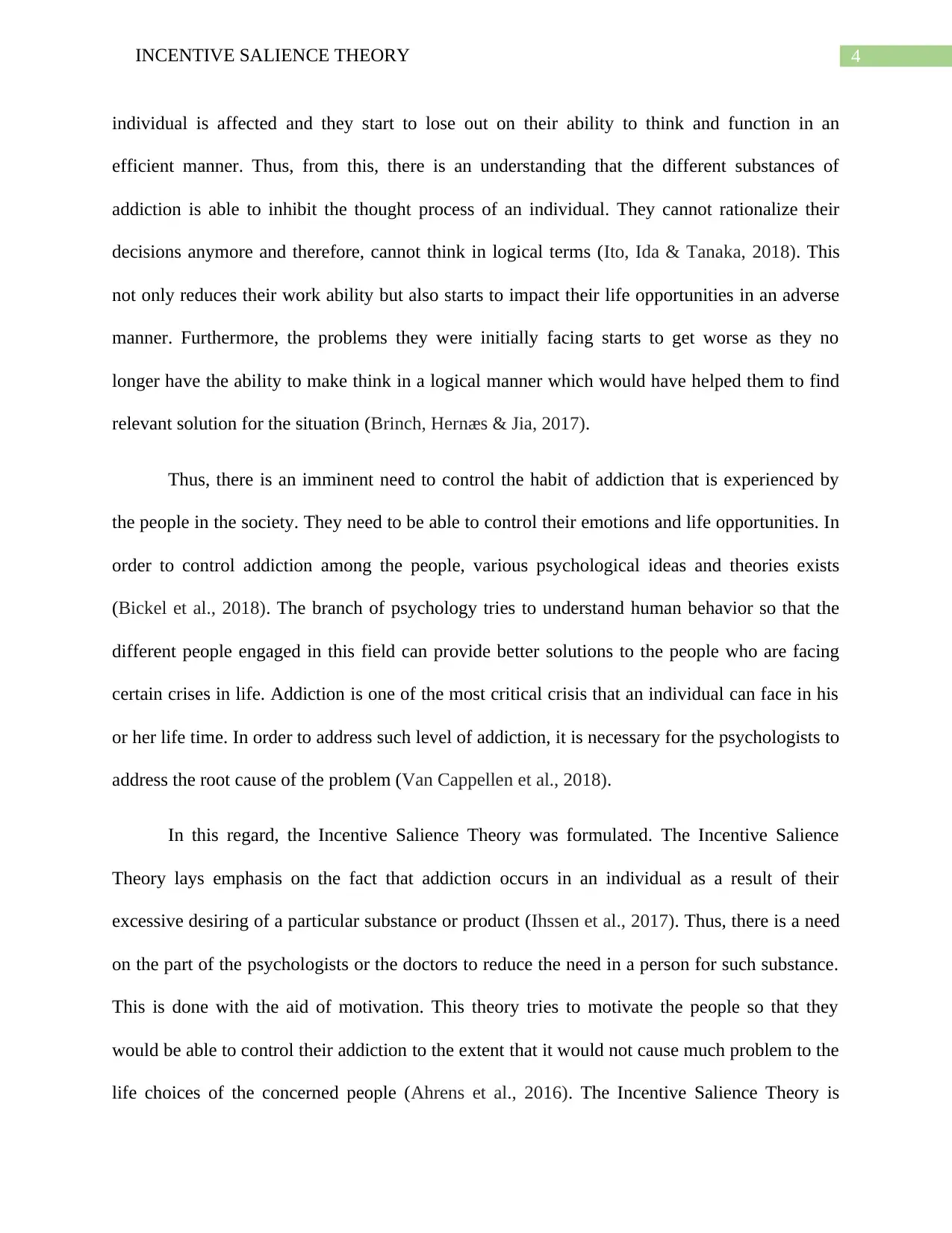
4INCENTIVE SALIENCE THEORY
individual is affected and they start to lose out on their ability to think and function in an
efficient manner. Thus, from this, there is an understanding that the different substances of
addiction is able to inhibit the thought process of an individual. They cannot rationalize their
decisions anymore and therefore, cannot think in logical terms (Ito, Ida & Tanaka, 2018). This
not only reduces their work ability but also starts to impact their life opportunities in an adverse
manner. Furthermore, the problems they were initially facing starts to get worse as they no
longer have the ability to make think in a logical manner which would have helped them to find
relevant solution for the situation (Brinch, Hernæs & Jia, 2017).
Thus, there is an imminent need to control the habit of addiction that is experienced by
the people in the society. They need to be able to control their emotions and life opportunities. In
order to control addiction among the people, various psychological ideas and theories exists
(Bickel et al., 2018). The branch of psychology tries to understand human behavior so that the
different people engaged in this field can provide better solutions to the people who are facing
certain crises in life. Addiction is one of the most critical crisis that an individual can face in his
or her life time. In order to address such level of addiction, it is necessary for the psychologists to
address the root cause of the problem (Van Cappellen et al., 2018).
In this regard, the Incentive Salience Theory was formulated. The Incentive Salience
Theory lays emphasis on the fact that addiction occurs in an individual as a result of their
excessive desiring of a particular substance or product (Ihssen et al., 2017). Thus, there is a need
on the part of the psychologists or the doctors to reduce the need in a person for such substance.
This is done with the aid of motivation. This theory tries to motivate the people so that they
would be able to control their addiction to the extent that it would not cause much problem to the
life choices of the concerned people (Ahrens et al., 2016). The Incentive Salience Theory is
individual is affected and they start to lose out on their ability to think and function in an
efficient manner. Thus, from this, there is an understanding that the different substances of
addiction is able to inhibit the thought process of an individual. They cannot rationalize their
decisions anymore and therefore, cannot think in logical terms (Ito, Ida & Tanaka, 2018). This
not only reduces their work ability but also starts to impact their life opportunities in an adverse
manner. Furthermore, the problems they were initially facing starts to get worse as they no
longer have the ability to make think in a logical manner which would have helped them to find
relevant solution for the situation (Brinch, Hernæs & Jia, 2017).
Thus, there is an imminent need to control the habit of addiction that is experienced by
the people in the society. They need to be able to control their emotions and life opportunities. In
order to control addiction among the people, various psychological ideas and theories exists
(Bickel et al., 2018). The branch of psychology tries to understand human behavior so that the
different people engaged in this field can provide better solutions to the people who are facing
certain crises in life. Addiction is one of the most critical crisis that an individual can face in his
or her life time. In order to address such level of addiction, it is necessary for the psychologists to
address the root cause of the problem (Van Cappellen et al., 2018).
In this regard, the Incentive Salience Theory was formulated. The Incentive Salience
Theory lays emphasis on the fact that addiction occurs in an individual as a result of their
excessive desiring of a particular substance or product (Ihssen et al., 2017). Thus, there is a need
on the part of the psychologists or the doctors to reduce the need in a person for such substance.
This is done with the aid of motivation. This theory tries to motivate the people so that they
would be able to control their addiction to the extent that it would not cause much problem to the
life choices of the concerned people (Ahrens et al., 2016). The Incentive Salience Theory is
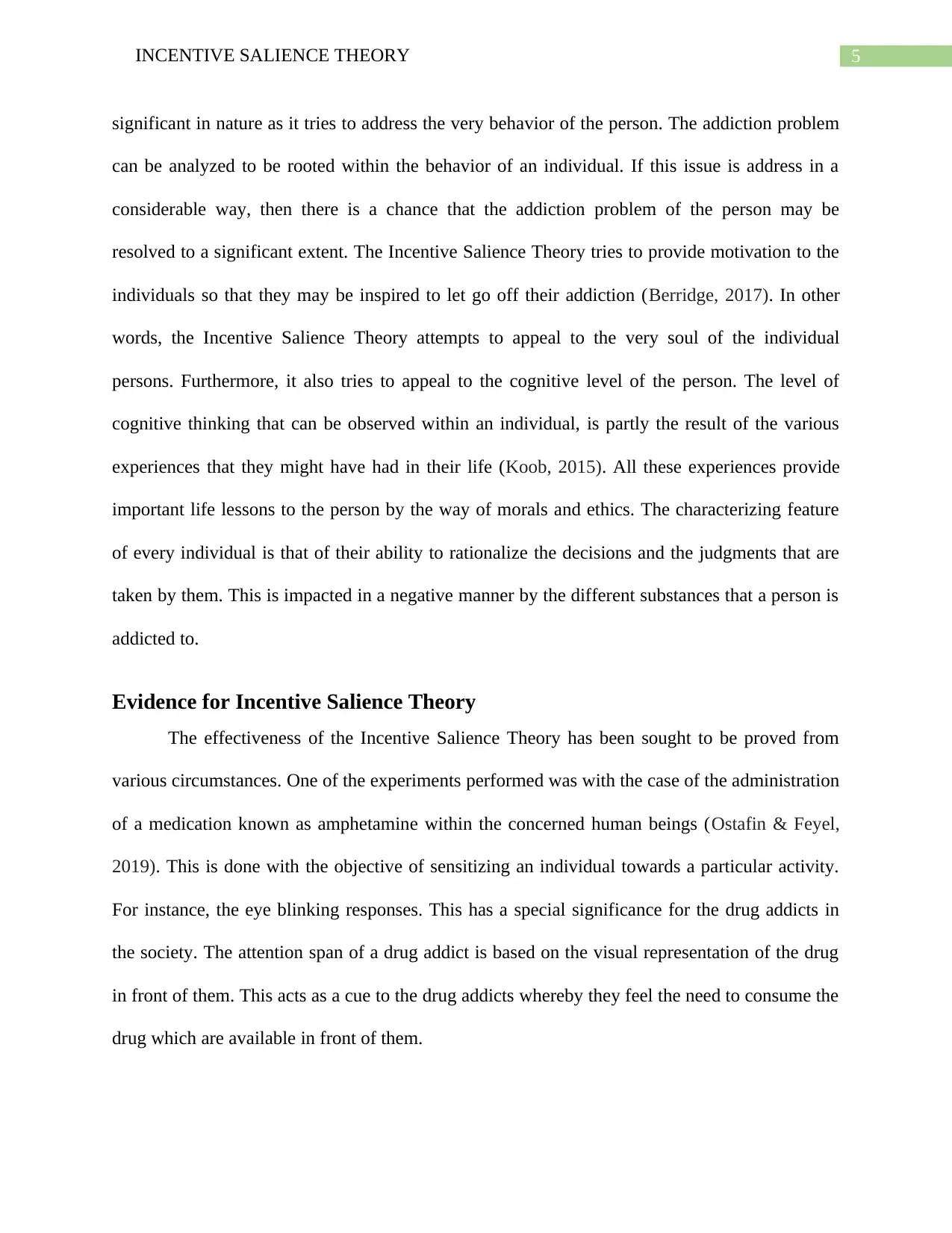
5INCENTIVE SALIENCE THEORY
significant in nature as it tries to address the very behavior of the person. The addiction problem
can be analyzed to be rooted within the behavior of an individual. If this issue is address in a
considerable way, then there is a chance that the addiction problem of the person may be
resolved to a significant extent. The Incentive Salience Theory tries to provide motivation to the
individuals so that they may be inspired to let go off their addiction (Berridge, 2017). In other
words, the Incentive Salience Theory attempts to appeal to the very soul of the individual
persons. Furthermore, it also tries to appeal to the cognitive level of the person. The level of
cognitive thinking that can be observed within an individual, is partly the result of the various
experiences that they might have had in their life (Koob, 2015). All these experiences provide
important life lessons to the person by the way of morals and ethics. The characterizing feature
of every individual is that of their ability to rationalize the decisions and the judgments that are
taken by them. This is impacted in a negative manner by the different substances that a person is
addicted to.
Evidence for Incentive Salience Theory
The effectiveness of the Incentive Salience Theory has been sought to be proved from
various circumstances. One of the experiments performed was with the case of the administration
of a medication known as amphetamine within the concerned human beings (Ostafin & Feyel,
2019). This is done with the objective of sensitizing an individual towards a particular activity.
For instance, the eye blinking responses. This has a special significance for the drug addicts in
the society. The attention span of a drug addict is based on the visual representation of the drug
in front of them. This acts as a cue to the drug addicts whereby they feel the need to consume the
drug which are available in front of them.
significant in nature as it tries to address the very behavior of the person. The addiction problem
can be analyzed to be rooted within the behavior of an individual. If this issue is address in a
considerable way, then there is a chance that the addiction problem of the person may be
resolved to a significant extent. The Incentive Salience Theory tries to provide motivation to the
individuals so that they may be inspired to let go off their addiction (Berridge, 2017). In other
words, the Incentive Salience Theory attempts to appeal to the very soul of the individual
persons. Furthermore, it also tries to appeal to the cognitive level of the person. The level of
cognitive thinking that can be observed within an individual, is partly the result of the various
experiences that they might have had in their life (Koob, 2015). All these experiences provide
important life lessons to the person by the way of morals and ethics. The characterizing feature
of every individual is that of their ability to rationalize the decisions and the judgments that are
taken by them. This is impacted in a negative manner by the different substances that a person is
addicted to.
Evidence for Incentive Salience Theory
The effectiveness of the Incentive Salience Theory has been sought to be proved from
various circumstances. One of the experiments performed was with the case of the administration
of a medication known as amphetamine within the concerned human beings (Ostafin & Feyel,
2019). This is done with the objective of sensitizing an individual towards a particular activity.
For instance, the eye blinking responses. This has a special significance for the drug addicts in
the society. The attention span of a drug addict is based on the visual representation of the drug
in front of them. This acts as a cue to the drug addicts whereby they feel the need to consume the
drug which are available in front of them.
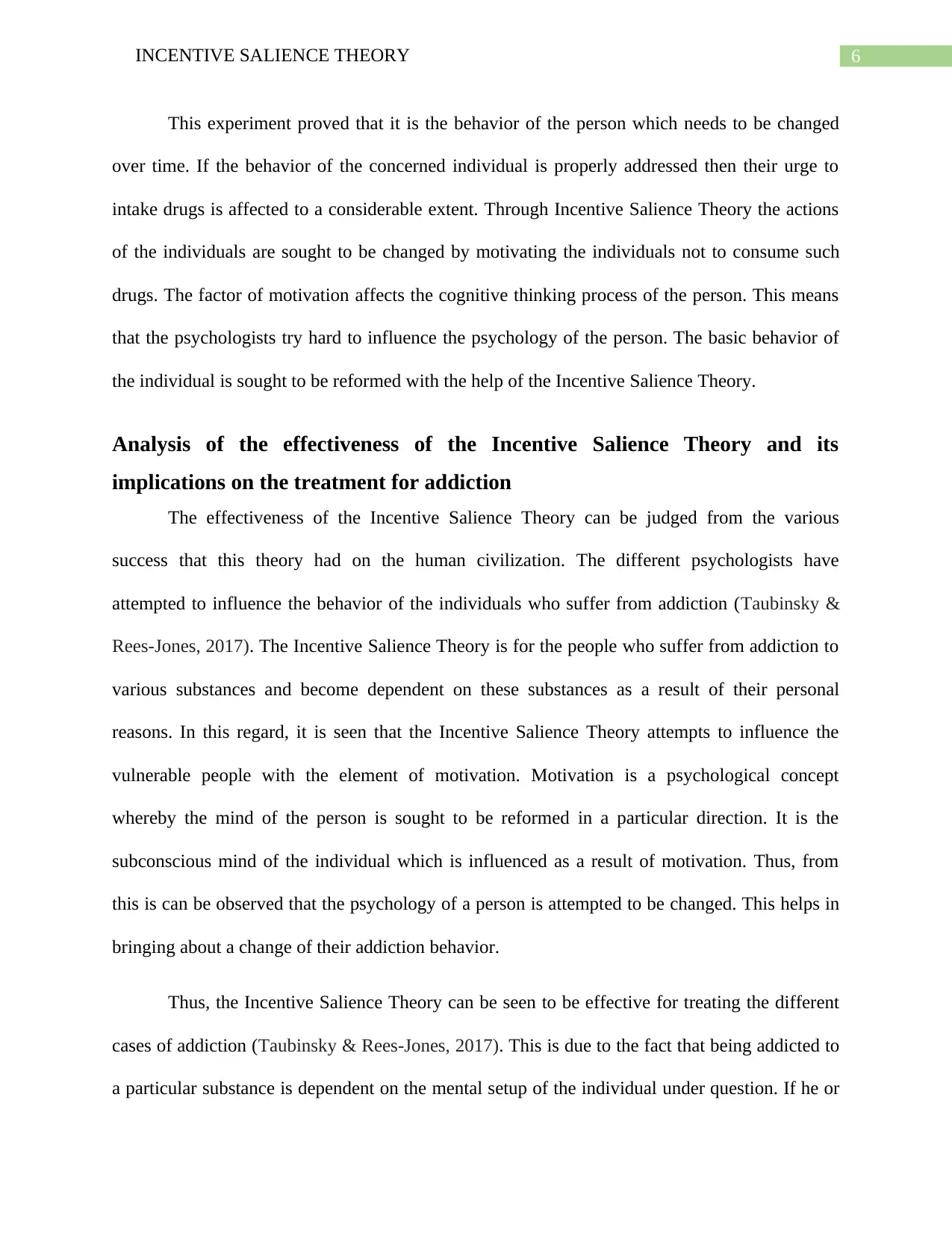
6INCENTIVE SALIENCE THEORY
This experiment proved that it is the behavior of the person which needs to be changed
over time. If the behavior of the concerned individual is properly addressed then their urge to
intake drugs is affected to a considerable extent. Through Incentive Salience Theory the actions
of the individuals are sought to be changed by motivating the individuals not to consume such
drugs. The factor of motivation affects the cognitive thinking process of the person. This means
that the psychologists try hard to influence the psychology of the person. The basic behavior of
the individual is sought to be reformed with the help of the Incentive Salience Theory.
Analysis of the effectiveness of the Incentive Salience Theory and its
implications on the treatment for addiction
The effectiveness of the Incentive Salience Theory can be judged from the various
success that this theory had on the human civilization. The different psychologists have
attempted to influence the behavior of the individuals who suffer from addiction (Taubinsky &
Rees-Jones, 2017). The Incentive Salience Theory is for the people who suffer from addiction to
various substances and become dependent on these substances as a result of their personal
reasons. In this regard, it is seen that the Incentive Salience Theory attempts to influence the
vulnerable people with the element of motivation. Motivation is a psychological concept
whereby the mind of the person is sought to be reformed in a particular direction. It is the
subconscious mind of the individual which is influenced as a result of motivation. Thus, from
this is can be observed that the psychology of a person is attempted to be changed. This helps in
bringing about a change of their addiction behavior.
Thus, the Incentive Salience Theory can be seen to be effective for treating the different
cases of addiction (Taubinsky & Rees-Jones, 2017). This is due to the fact that being addicted to
a particular substance is dependent on the mental setup of the individual under question. If he or
This experiment proved that it is the behavior of the person which needs to be changed
over time. If the behavior of the concerned individual is properly addressed then their urge to
intake drugs is affected to a considerable extent. Through Incentive Salience Theory the actions
of the individuals are sought to be changed by motivating the individuals not to consume such
drugs. The factor of motivation affects the cognitive thinking process of the person. This means
that the psychologists try hard to influence the psychology of the person. The basic behavior of
the individual is sought to be reformed with the help of the Incentive Salience Theory.
Analysis of the effectiveness of the Incentive Salience Theory and its
implications on the treatment for addiction
The effectiveness of the Incentive Salience Theory can be judged from the various
success that this theory had on the human civilization. The different psychologists have
attempted to influence the behavior of the individuals who suffer from addiction (Taubinsky &
Rees-Jones, 2017). The Incentive Salience Theory is for the people who suffer from addiction to
various substances and become dependent on these substances as a result of their personal
reasons. In this regard, it is seen that the Incentive Salience Theory attempts to influence the
vulnerable people with the element of motivation. Motivation is a psychological concept
whereby the mind of the person is sought to be reformed in a particular direction. It is the
subconscious mind of the individual which is influenced as a result of motivation. Thus, from
this is can be observed that the psychology of a person is attempted to be changed. This helps in
bringing about a change of their addiction behavior.
Thus, the Incentive Salience Theory can be seen to be effective for treating the different
cases of addiction (Taubinsky & Rees-Jones, 2017). This is due to the fact that being addicted to
a particular substance is dependent on the mental setup of the individual under question. If he or
Paraphrase This Document
Need a fresh take? Get an instant paraphrase of this document with our AI Paraphraser
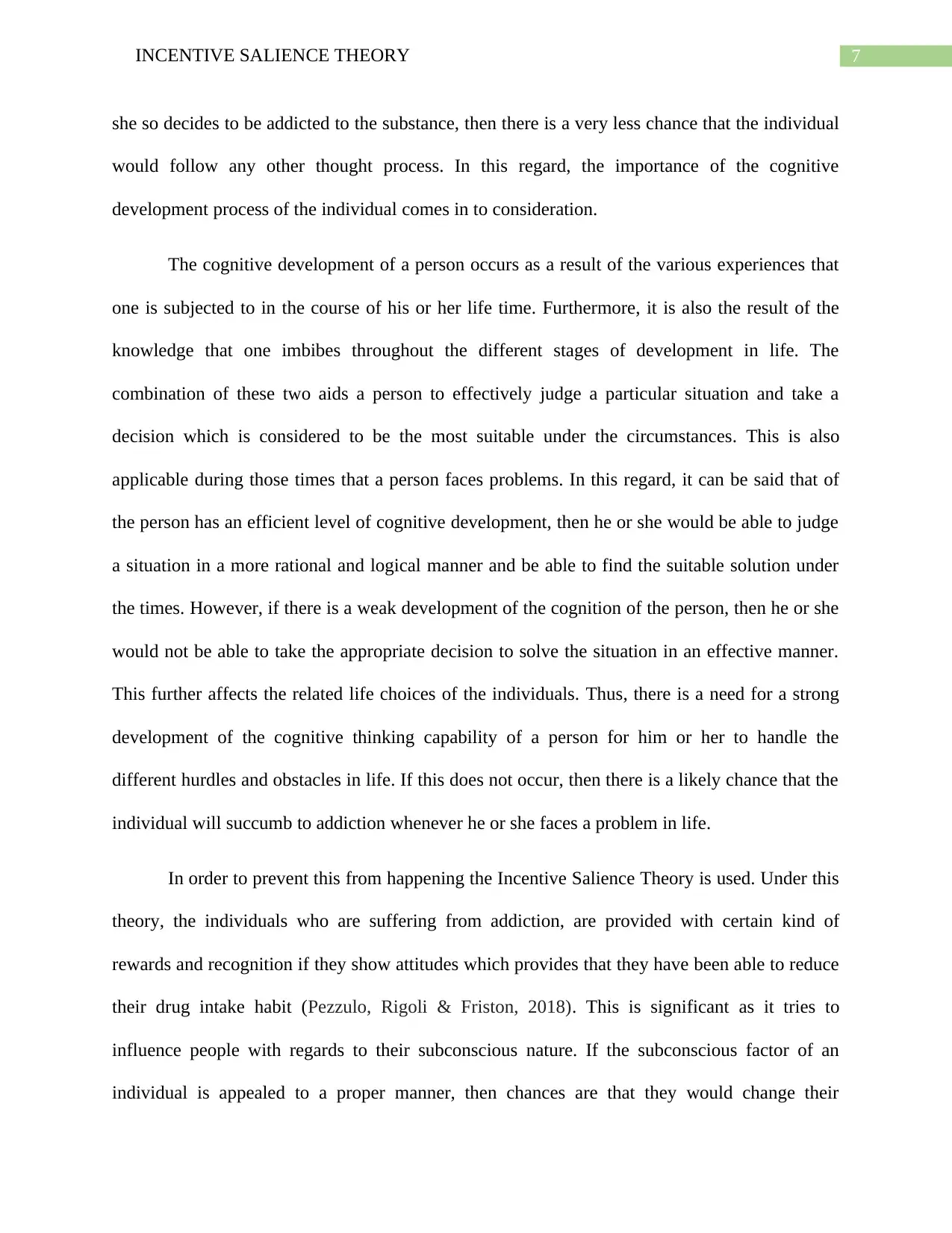
7INCENTIVE SALIENCE THEORY
she so decides to be addicted to the substance, then there is a very less chance that the individual
would follow any other thought process. In this regard, the importance of the cognitive
development process of the individual comes in to consideration.
The cognitive development of a person occurs as a result of the various experiences that
one is subjected to in the course of his or her life time. Furthermore, it is also the result of the
knowledge that one imbibes throughout the different stages of development in life. The
combination of these two aids a person to effectively judge a particular situation and take a
decision which is considered to be the most suitable under the circumstances. This is also
applicable during those times that a person faces problems. In this regard, it can be said that of
the person has an efficient level of cognitive development, then he or she would be able to judge
a situation in a more rational and logical manner and be able to find the suitable solution under
the times. However, if there is a weak development of the cognition of the person, then he or she
would not be able to take the appropriate decision to solve the situation in an effective manner.
This further affects the related life choices of the individuals. Thus, there is a need for a strong
development of the cognitive thinking capability of a person for him or her to handle the
different hurdles and obstacles in life. If this does not occur, then there is a likely chance that the
individual will succumb to addiction whenever he or she faces a problem in life.
In order to prevent this from happening the Incentive Salience Theory is used. Under this
theory, the individuals who are suffering from addiction, are provided with certain kind of
rewards and recognition if they show attitudes which provides that they have been able to reduce
their drug intake habit (Pezzulo, Rigoli & Friston, 2018). This is significant as it tries to
influence people with regards to their subconscious nature. If the subconscious factor of an
individual is appealed to a proper manner, then chances are that they would change their
she so decides to be addicted to the substance, then there is a very less chance that the individual
would follow any other thought process. In this regard, the importance of the cognitive
development process of the individual comes in to consideration.
The cognitive development of a person occurs as a result of the various experiences that
one is subjected to in the course of his or her life time. Furthermore, it is also the result of the
knowledge that one imbibes throughout the different stages of development in life. The
combination of these two aids a person to effectively judge a particular situation and take a
decision which is considered to be the most suitable under the circumstances. This is also
applicable during those times that a person faces problems. In this regard, it can be said that of
the person has an efficient level of cognitive development, then he or she would be able to judge
a situation in a more rational and logical manner and be able to find the suitable solution under
the times. However, if there is a weak development of the cognition of the person, then he or she
would not be able to take the appropriate decision to solve the situation in an effective manner.
This further affects the related life choices of the individuals. Thus, there is a need for a strong
development of the cognitive thinking capability of a person for him or her to handle the
different hurdles and obstacles in life. If this does not occur, then there is a likely chance that the
individual will succumb to addiction whenever he or she faces a problem in life.
In order to prevent this from happening the Incentive Salience Theory is used. Under this
theory, the individuals who are suffering from addiction, are provided with certain kind of
rewards and recognition if they show attitudes which provides that they have been able to reduce
their drug intake habit (Pezzulo, Rigoli & Friston, 2018). This is significant as it tries to
influence people with regards to their subconscious nature. If the subconscious factor of an
individual is appealed to a proper manner, then chances are that they would change their
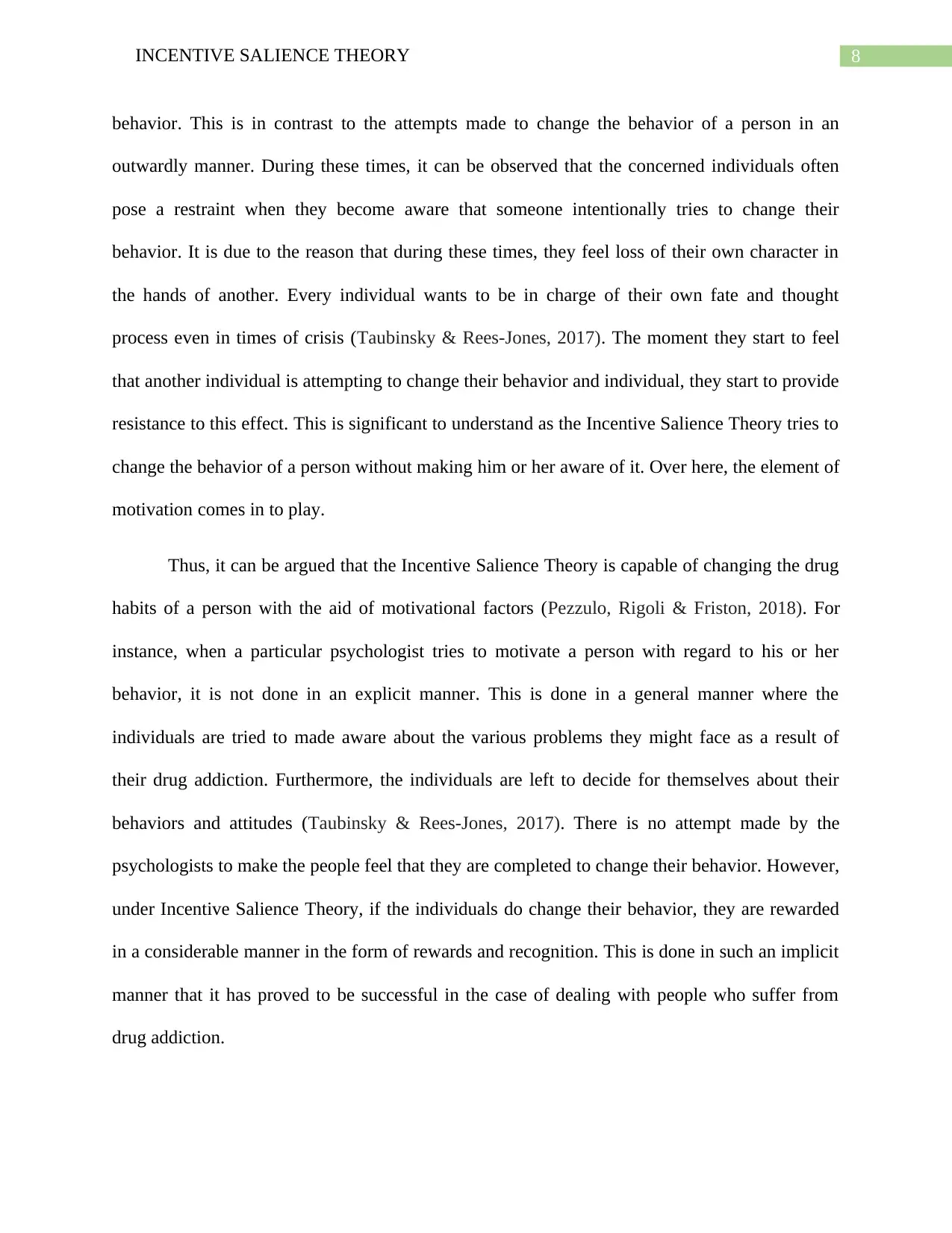
8INCENTIVE SALIENCE THEORY
behavior. This is in contrast to the attempts made to change the behavior of a person in an
outwardly manner. During these times, it can be observed that the concerned individuals often
pose a restraint when they become aware that someone intentionally tries to change their
behavior. It is due to the reason that during these times, they feel loss of their own character in
the hands of another. Every individual wants to be in charge of their own fate and thought
process even in times of crisis (Taubinsky & Rees-Jones, 2017). The moment they start to feel
that another individual is attempting to change their behavior and individual, they start to provide
resistance to this effect. This is significant to understand as the Incentive Salience Theory tries to
change the behavior of a person without making him or her aware of it. Over here, the element of
motivation comes in to play.
Thus, it can be argued that the Incentive Salience Theory is capable of changing the drug
habits of a person with the aid of motivational factors (Pezzulo, Rigoli & Friston, 2018). For
instance, when a particular psychologist tries to motivate a person with regard to his or her
behavior, it is not done in an explicit manner. This is done in a general manner where the
individuals are tried to made aware about the various problems they might face as a result of
their drug addiction. Furthermore, the individuals are left to decide for themselves about their
behaviors and attitudes (Taubinsky & Rees-Jones, 2017). There is no attempt made by the
psychologists to make the people feel that they are completed to change their behavior. However,
under Incentive Salience Theory, if the individuals do change their behavior, they are rewarded
in a considerable manner in the form of rewards and recognition. This is done in such an implicit
manner that it has proved to be successful in the case of dealing with people who suffer from
drug addiction.
behavior. This is in contrast to the attempts made to change the behavior of a person in an
outwardly manner. During these times, it can be observed that the concerned individuals often
pose a restraint when they become aware that someone intentionally tries to change their
behavior. It is due to the reason that during these times, they feel loss of their own character in
the hands of another. Every individual wants to be in charge of their own fate and thought
process even in times of crisis (Taubinsky & Rees-Jones, 2017). The moment they start to feel
that another individual is attempting to change their behavior and individual, they start to provide
resistance to this effect. This is significant to understand as the Incentive Salience Theory tries to
change the behavior of a person without making him or her aware of it. Over here, the element of
motivation comes in to play.
Thus, it can be argued that the Incentive Salience Theory is capable of changing the drug
habits of a person with the aid of motivational factors (Pezzulo, Rigoli & Friston, 2018). For
instance, when a particular psychologist tries to motivate a person with regard to his or her
behavior, it is not done in an explicit manner. This is done in a general manner where the
individuals are tried to made aware about the various problems they might face as a result of
their drug addiction. Furthermore, the individuals are left to decide for themselves about their
behaviors and attitudes (Taubinsky & Rees-Jones, 2017). There is no attempt made by the
psychologists to make the people feel that they are completed to change their behavior. However,
under Incentive Salience Theory, if the individuals do change their behavior, they are rewarded
in a considerable manner in the form of rewards and recognition. This is done in such an implicit
manner that it has proved to be successful in the case of dealing with people who suffer from
drug addiction.
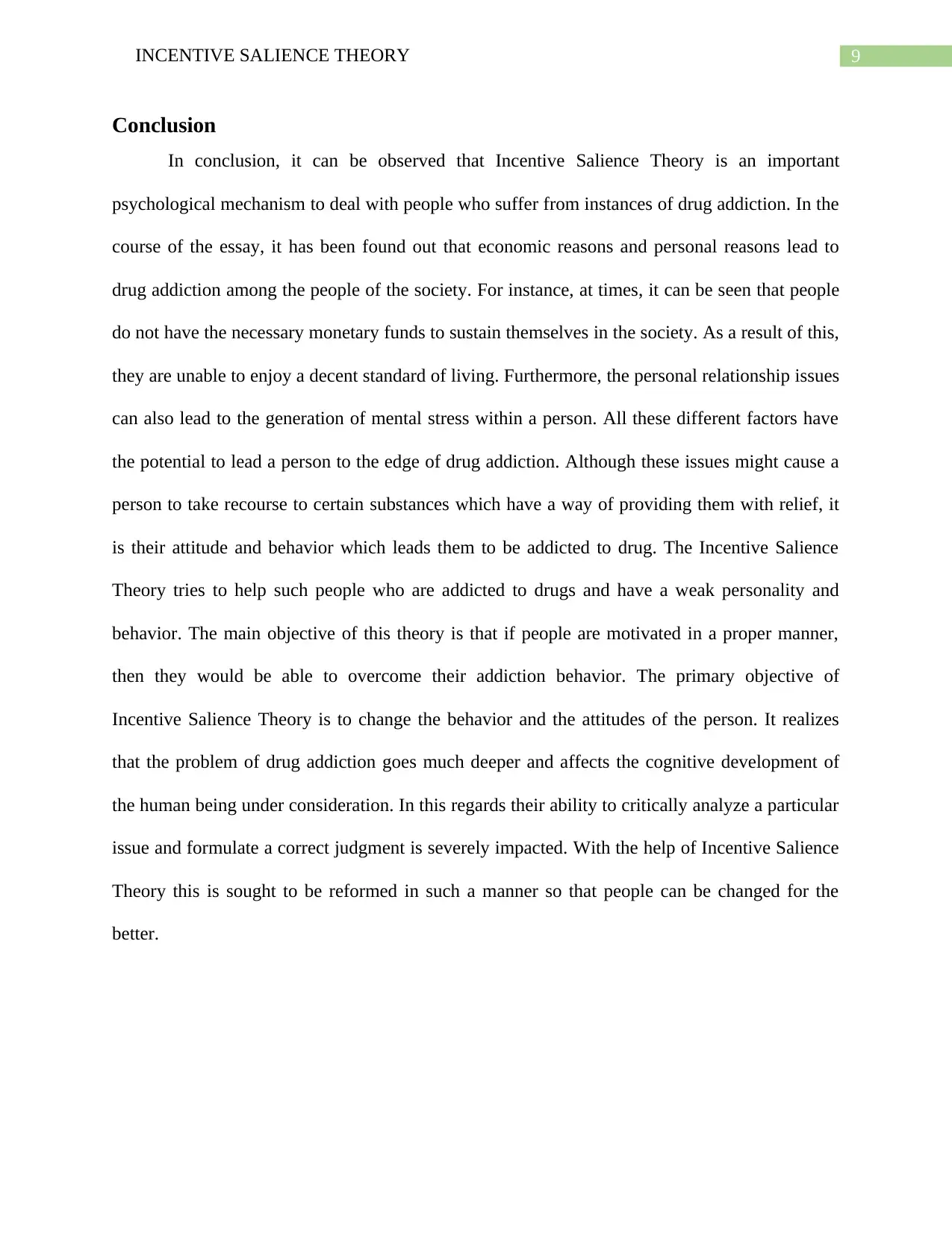
9INCENTIVE SALIENCE THEORY
Conclusion
In conclusion, it can be observed that Incentive Salience Theory is an important
psychological mechanism to deal with people who suffer from instances of drug addiction. In the
course of the essay, it has been found out that economic reasons and personal reasons lead to
drug addiction among the people of the society. For instance, at times, it can be seen that people
do not have the necessary monetary funds to sustain themselves in the society. As a result of this,
they are unable to enjoy a decent standard of living. Furthermore, the personal relationship issues
can also lead to the generation of mental stress within a person. All these different factors have
the potential to lead a person to the edge of drug addiction. Although these issues might cause a
person to take recourse to certain substances which have a way of providing them with relief, it
is their attitude and behavior which leads them to be addicted to drug. The Incentive Salience
Theory tries to help such people who are addicted to drugs and have a weak personality and
behavior. The main objective of this theory is that if people are motivated in a proper manner,
then they would be able to overcome their addiction behavior. The primary objective of
Incentive Salience Theory is to change the behavior and the attitudes of the person. It realizes
that the problem of drug addiction goes much deeper and affects the cognitive development of
the human being under consideration. In this regards their ability to critically analyze a particular
issue and formulate a correct judgment is severely impacted. With the help of Incentive Salience
Theory this is sought to be reformed in such a manner so that people can be changed for the
better.
Conclusion
In conclusion, it can be observed that Incentive Salience Theory is an important
psychological mechanism to deal with people who suffer from instances of drug addiction. In the
course of the essay, it has been found out that economic reasons and personal reasons lead to
drug addiction among the people of the society. For instance, at times, it can be seen that people
do not have the necessary monetary funds to sustain themselves in the society. As a result of this,
they are unable to enjoy a decent standard of living. Furthermore, the personal relationship issues
can also lead to the generation of mental stress within a person. All these different factors have
the potential to lead a person to the edge of drug addiction. Although these issues might cause a
person to take recourse to certain substances which have a way of providing them with relief, it
is their attitude and behavior which leads them to be addicted to drug. The Incentive Salience
Theory tries to help such people who are addicted to drugs and have a weak personality and
behavior. The main objective of this theory is that if people are motivated in a proper manner,
then they would be able to overcome their addiction behavior. The primary objective of
Incentive Salience Theory is to change the behavior and the attitudes of the person. It realizes
that the problem of drug addiction goes much deeper and affects the cognitive development of
the human being under consideration. In this regards their ability to critically analyze a particular
issue and formulate a correct judgment is severely impacted. With the help of Incentive Salience
Theory this is sought to be reformed in such a manner so that people can be changed for the
better.
Secure Best Marks with AI Grader
Need help grading? Try our AI Grader for instant feedback on your assignments.
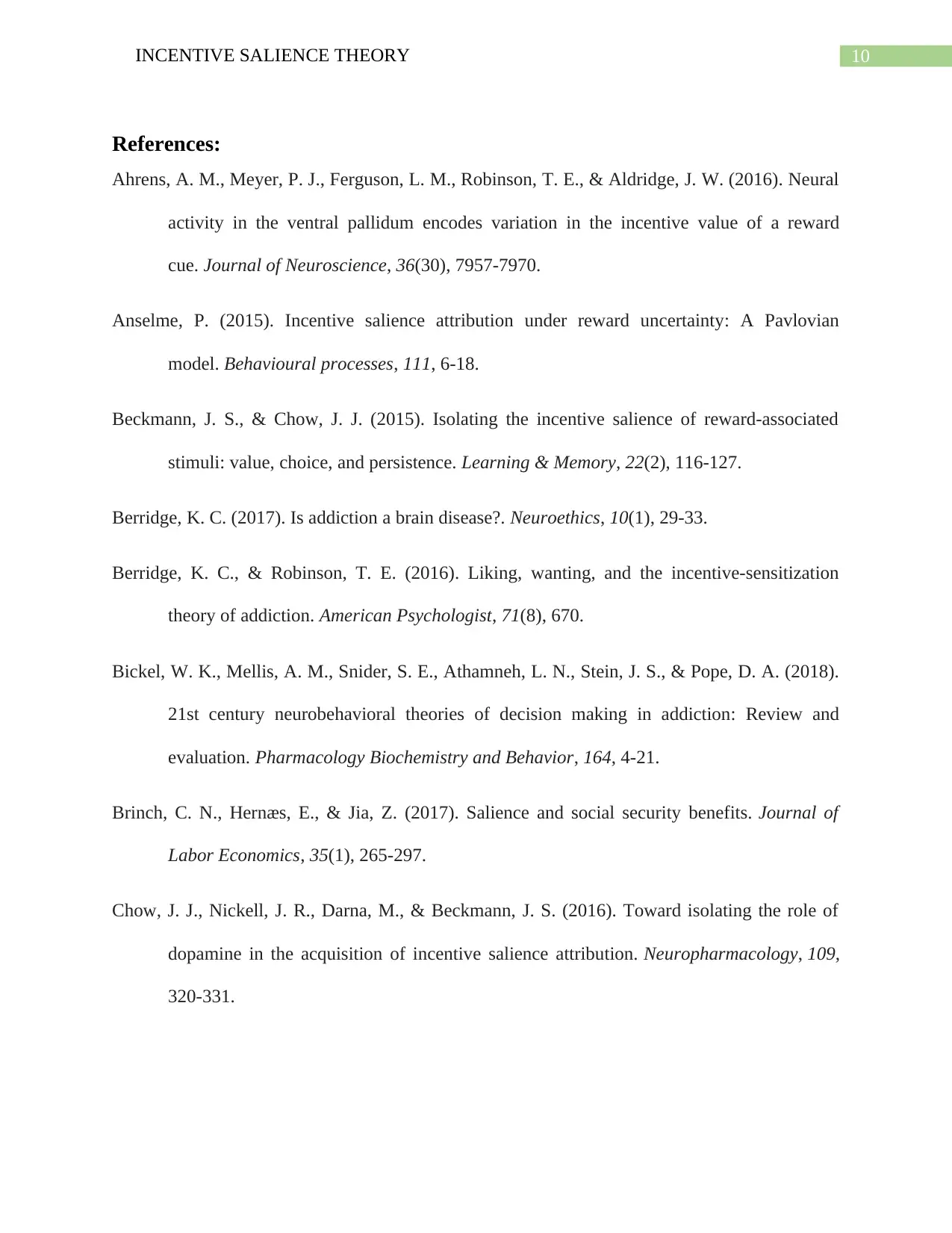
10INCENTIVE SALIENCE THEORY
References:
Ahrens, A. M., Meyer, P. J., Ferguson, L. M., Robinson, T. E., & Aldridge, J. W. (2016). Neural
activity in the ventral pallidum encodes variation in the incentive value of a reward
cue. Journal of Neuroscience, 36(30), 7957-7970.
Anselme, P. (2015). Incentive salience attribution under reward uncertainty: A Pavlovian
model. Behavioural processes, 111, 6-18.
Beckmann, J. S., & Chow, J. J. (2015). Isolating the incentive salience of reward-associated
stimuli: value, choice, and persistence. Learning & Memory, 22(2), 116-127.
Berridge, K. C. (2017). Is addiction a brain disease?. Neuroethics, 10(1), 29-33.
Berridge, K. C., & Robinson, T. E. (2016). Liking, wanting, and the incentive-sensitization
theory of addiction. American Psychologist, 71(8), 670.
Bickel, W. K., Mellis, A. M., Snider, S. E., Athamneh, L. N., Stein, J. S., & Pope, D. A. (2018).
21st century neurobehavioral theories of decision making in addiction: Review and
evaluation. Pharmacology Biochemistry and Behavior, 164, 4-21.
Brinch, C. N., Hernæs, E., & Jia, Z. (2017). Salience and social security benefits. Journal of
Labor Economics, 35(1), 265-297.
Chow, J. J., Nickell, J. R., Darna, M., & Beckmann, J. S. (2016). Toward isolating the role of
dopamine in the acquisition of incentive salience attribution. Neuropharmacology, 109,
320-331.
References:
Ahrens, A. M., Meyer, P. J., Ferguson, L. M., Robinson, T. E., & Aldridge, J. W. (2016). Neural
activity in the ventral pallidum encodes variation in the incentive value of a reward
cue. Journal of Neuroscience, 36(30), 7957-7970.
Anselme, P. (2015). Incentive salience attribution under reward uncertainty: A Pavlovian
model. Behavioural processes, 111, 6-18.
Beckmann, J. S., & Chow, J. J. (2015). Isolating the incentive salience of reward-associated
stimuli: value, choice, and persistence. Learning & Memory, 22(2), 116-127.
Berridge, K. C. (2017). Is addiction a brain disease?. Neuroethics, 10(1), 29-33.
Berridge, K. C., & Robinson, T. E. (2016). Liking, wanting, and the incentive-sensitization
theory of addiction. American Psychologist, 71(8), 670.
Bickel, W. K., Mellis, A. M., Snider, S. E., Athamneh, L. N., Stein, J. S., & Pope, D. A. (2018).
21st century neurobehavioral theories of decision making in addiction: Review and
evaluation. Pharmacology Biochemistry and Behavior, 164, 4-21.
Brinch, C. N., Hernæs, E., & Jia, Z. (2017). Salience and social security benefits. Journal of
Labor Economics, 35(1), 265-297.
Chow, J. J., Nickell, J. R., Darna, M., & Beckmann, J. S. (2016). Toward isolating the role of
dopamine in the acquisition of incentive salience attribution. Neuropharmacology, 109,
320-331.
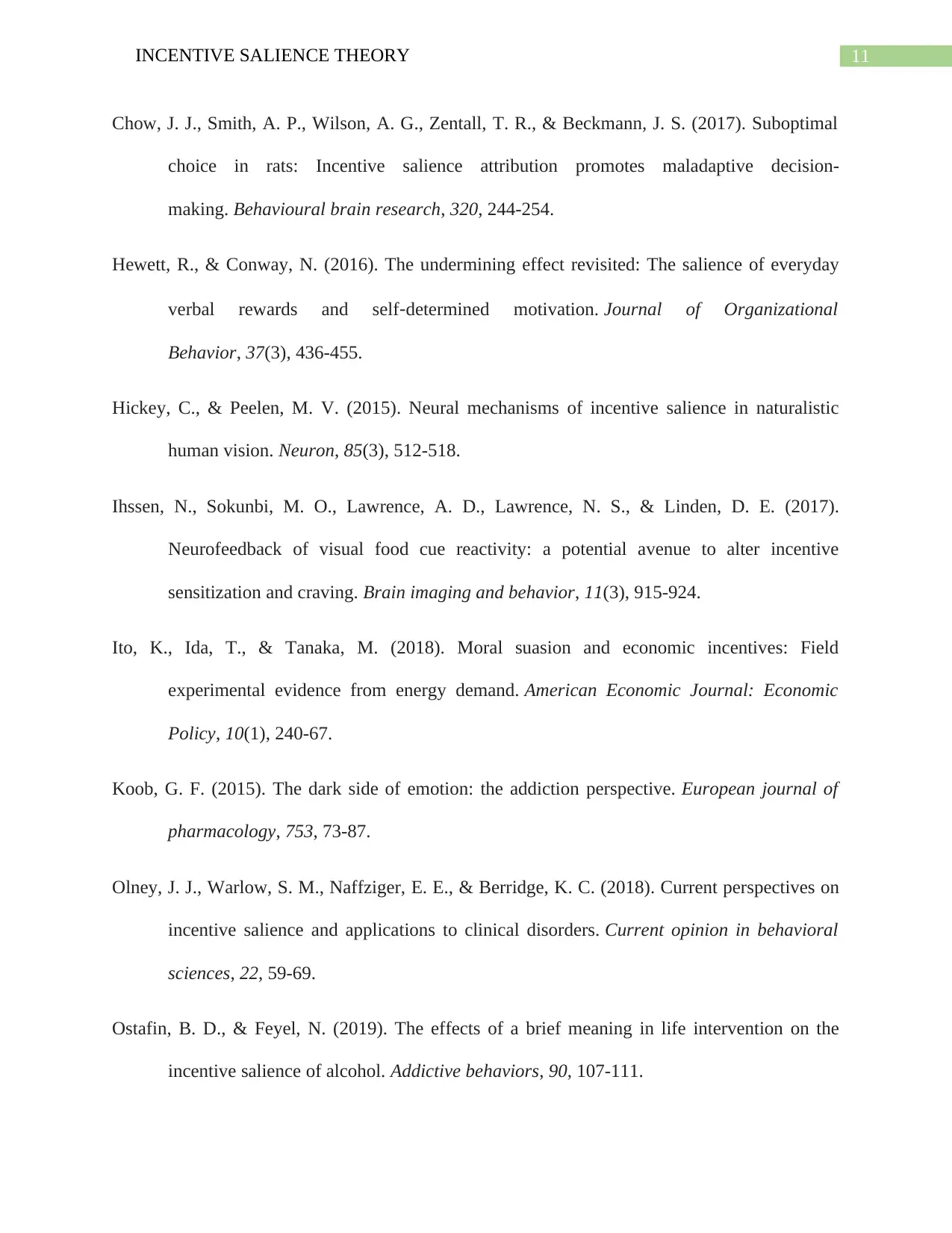
11INCENTIVE SALIENCE THEORY
Chow, J. J., Smith, A. P., Wilson, A. G., Zentall, T. R., & Beckmann, J. S. (2017). Suboptimal
choice in rats: Incentive salience attribution promotes maladaptive decision-
making. Behavioural brain research, 320, 244-254.
Hewett, R., & Conway, N. (2016). The undermining effect revisited: The salience of everyday
verbal rewards and self‐determined motivation. Journal of Organizational
Behavior, 37(3), 436-455.
Hickey, C., & Peelen, M. V. (2015). Neural mechanisms of incentive salience in naturalistic
human vision. Neuron, 85(3), 512-518.
Ihssen, N., Sokunbi, M. O., Lawrence, A. D., Lawrence, N. S., & Linden, D. E. (2017).
Neurofeedback of visual food cue reactivity: a potential avenue to alter incentive
sensitization and craving. Brain imaging and behavior, 11(3), 915-924.
Ito, K., Ida, T., & Tanaka, M. (2018). Moral suasion and economic incentives: Field
experimental evidence from energy demand. American Economic Journal: Economic
Policy, 10(1), 240-67.
Koob, G. F. (2015). The dark side of emotion: the addiction perspective. European journal of
pharmacology, 753, 73-87.
Olney, J. J., Warlow, S. M., Naffziger, E. E., & Berridge, K. C. (2018). Current perspectives on
incentive salience and applications to clinical disorders. Current opinion in behavioral
sciences, 22, 59-69.
Ostafin, B. D., & Feyel, N. (2019). The effects of a brief meaning in life intervention on the
incentive salience of alcohol. Addictive behaviors, 90, 107-111.
Chow, J. J., Smith, A. P., Wilson, A. G., Zentall, T. R., & Beckmann, J. S. (2017). Suboptimal
choice in rats: Incentive salience attribution promotes maladaptive decision-
making. Behavioural brain research, 320, 244-254.
Hewett, R., & Conway, N. (2016). The undermining effect revisited: The salience of everyday
verbal rewards and self‐determined motivation. Journal of Organizational
Behavior, 37(3), 436-455.
Hickey, C., & Peelen, M. V. (2015). Neural mechanisms of incentive salience in naturalistic
human vision. Neuron, 85(3), 512-518.
Ihssen, N., Sokunbi, M. O., Lawrence, A. D., Lawrence, N. S., & Linden, D. E. (2017).
Neurofeedback of visual food cue reactivity: a potential avenue to alter incentive
sensitization and craving. Brain imaging and behavior, 11(3), 915-924.
Ito, K., Ida, T., & Tanaka, M. (2018). Moral suasion and economic incentives: Field
experimental evidence from energy demand. American Economic Journal: Economic
Policy, 10(1), 240-67.
Koob, G. F. (2015). The dark side of emotion: the addiction perspective. European journal of
pharmacology, 753, 73-87.
Olney, J. J., Warlow, S. M., Naffziger, E. E., & Berridge, K. C. (2018). Current perspectives on
incentive salience and applications to clinical disorders. Current opinion in behavioral
sciences, 22, 59-69.
Ostafin, B. D., & Feyel, N. (2019). The effects of a brief meaning in life intervention on the
incentive salience of alcohol. Addictive behaviors, 90, 107-111.
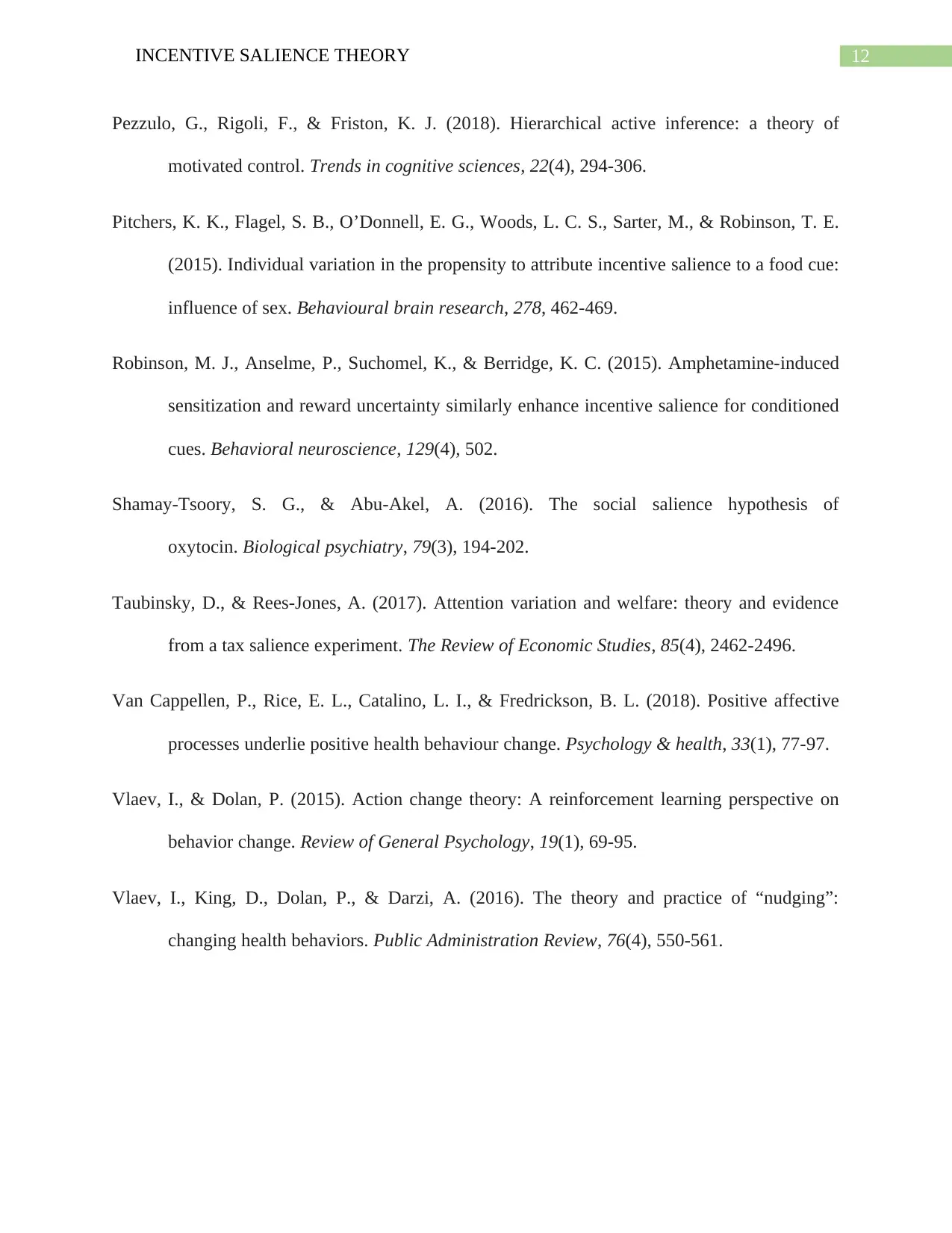
12INCENTIVE SALIENCE THEORY
Pezzulo, G., Rigoli, F., & Friston, K. J. (2018). Hierarchical active inference: a theory of
motivated control. Trends in cognitive sciences, 22(4), 294-306.
Pitchers, K. K., Flagel, S. B., O’Donnell, E. G., Woods, L. C. S., Sarter, M., & Robinson, T. E.
(2015). Individual variation in the propensity to attribute incentive salience to a food cue:
influence of sex. Behavioural brain research, 278, 462-469.
Robinson, M. J., Anselme, P., Suchomel, K., & Berridge, K. C. (2015). Amphetamine-induced
sensitization and reward uncertainty similarly enhance incentive salience for conditioned
cues. Behavioral neuroscience, 129(4), 502.
Shamay-Tsoory, S. G., & Abu-Akel, A. (2016). The social salience hypothesis of
oxytocin. Biological psychiatry, 79(3), 194-202.
Taubinsky, D., & Rees-Jones, A. (2017). Attention variation and welfare: theory and evidence
from a tax salience experiment. The Review of Economic Studies, 85(4), 2462-2496.
Van Cappellen, P., Rice, E. L., Catalino, L. I., & Fredrickson, B. L. (2018). Positive affective
processes underlie positive health behaviour change. Psychology & health, 33(1), 77-97.
Vlaev, I., & Dolan, P. (2015). Action change theory: A reinforcement learning perspective on
behavior change. Review of General Psychology, 19(1), 69-95.
Vlaev, I., King, D., Dolan, P., & Darzi, A. (2016). The theory and practice of “nudging”:
changing health behaviors. Public Administration Review, 76(4), 550-561.
Pezzulo, G., Rigoli, F., & Friston, K. J. (2018). Hierarchical active inference: a theory of
motivated control. Trends in cognitive sciences, 22(4), 294-306.
Pitchers, K. K., Flagel, S. B., O’Donnell, E. G., Woods, L. C. S., Sarter, M., & Robinson, T. E.
(2015). Individual variation in the propensity to attribute incentive salience to a food cue:
influence of sex. Behavioural brain research, 278, 462-469.
Robinson, M. J., Anselme, P., Suchomel, K., & Berridge, K. C. (2015). Amphetamine-induced
sensitization and reward uncertainty similarly enhance incentive salience for conditioned
cues. Behavioral neuroscience, 129(4), 502.
Shamay-Tsoory, S. G., & Abu-Akel, A. (2016). The social salience hypothesis of
oxytocin. Biological psychiatry, 79(3), 194-202.
Taubinsky, D., & Rees-Jones, A. (2017). Attention variation and welfare: theory and evidence
from a tax salience experiment. The Review of Economic Studies, 85(4), 2462-2496.
Van Cappellen, P., Rice, E. L., Catalino, L. I., & Fredrickson, B. L. (2018). Positive affective
processes underlie positive health behaviour change. Psychology & health, 33(1), 77-97.
Vlaev, I., & Dolan, P. (2015). Action change theory: A reinforcement learning perspective on
behavior change. Review of General Psychology, 19(1), 69-95.
Vlaev, I., King, D., Dolan, P., & Darzi, A. (2016). The theory and practice of “nudging”:
changing health behaviors. Public Administration Review, 76(4), 550-561.
1 out of 13
Related Documents
Your All-in-One AI-Powered Toolkit for Academic Success.
+13062052269
info@desklib.com
Available 24*7 on WhatsApp / Email
![[object Object]](/_next/static/media/star-bottom.7253800d.svg)
Unlock your academic potential
© 2024 | Zucol Services PVT LTD | All rights reserved.





